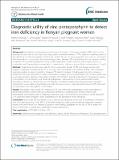| dc.contributor.author | Martin N Mwangi, Sumi Maskey, Pauline EA Andang’o, Noel K Shinali, Johanna M Roth, Laura Trijsburg, Alice M Mwangi, Han Zuilhof, Barend van Lagen, Huub FJ Savelkoul, Ayşe Y Demir, Hans Verhoef | |
| dc.date.accessioned | 2020-08-14T10:18:34Z | |
| dc.date.available | 2020-08-14T10:18:34Z | |
| dc.date.issued | 2014-12-01 | |
| dc.identifier.uri | https://repository.maseno.ac.ke/handle/123456789/2127 | |
| dc.description.abstract | Iron-deficient erythropoiesis results in excess formation of zinc protoporphyrin (ZPP), which can be measured instantly and at low assay cost using portable haematofluorometers. ZPP is used as a screening marker of iron deficiency in individual pregnant women and children, but also to assess population iron status in combination with haemoglobin concentration. We examined associations between ZPP and disorders that are common in Africa. In addition, we assessed the diagnostic utility of ZPP (measured in whole blood and erythrocytes), alone or in combination with haemoglobin concentration, in detecting iron deficiency (plasma ferritin concentration <15 μg/L).
Methods
Single blood samples were collected from a population sample of 470 rural Kenyan women with singleton pregnancies, gestational age 13 to 23 weeks, and … | en_US |
| dc.publisher | BioMed Central | en_US |
| dc.subject | Erythrocyte protoporphyrin, Iron deficiency, Kenya, Malaria, Plasmodium, Pregnancy, Zinc protoporphyrin | en_US |
| dc.subject | Erythrocyte protoporphyrin, Iron deficiency, Kenya, Malaria, Plasmodium, Pregnancy, Zinc protoporphyrin | en_US |
| dc.title | Diagnostic utility of zinc protoporphyrin to detect iron deficiency in Kenyan pregnant women | en_US |
| dc.type | Article | en_US |

